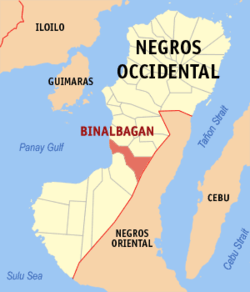Binalbagan
| Binalbagan | |
|---|---|
| Municipality | |
| Municipality of Binalbagan | |
 Map of Negros Occidental with Binalbagan highlighted | |
.svg.png) Binalbagan Location within the Philippines | |
| Coordinates: 10°12′N 122°52′E / 10.200°N 122.867°ECoordinates: 10°12′N 122°52′E / 10.200°N 122.867°E | |
| Country |
|
| Region | Negros Island Region (NIR) |
| Province | Negros Occidental |
| Congr. district | 5th district of Negros Occidental |
| Incorporated | May 15, 1572 (town) |
| Barangays | 16 |
| Government[1] | |
| • Mayor | Emmanuel Aranda |
| Area[2] | |
| • Total | 189.96 km2 (73.34 sq mi) |
| Population (2010)[3] | |
| • Total | 65,431 |
| • Density | 340/km2 (890/sq mi) |
| Time zone | PST (UTC+8) |
| ZIP code | 6107 |
| Area code | 34 |
| Languages | Hiligaynon (Ilonggo), Tagalog, English |
| Website | binalbagan.gov.ph |
Binalbagan is a first class municipality in the province of Negros Occidental, Philippines. According to the 2010 census, it has a population of 65,431 people.[3] Major economic activities include manufacturing, agriculture, services, cottage industries and tourism. Binalbagan is also known for the Binalbagan Isabela Sugar Company (BISCOM).
Binalbagan became a town on May 15, 1572[4] and was one of the first two settlements (the second being the municipality of Ilog). On the record, Binalbagan is the oldest town in the Negros Island Region, thereby earning the title, “Banwang Panganay” or oldest town. The Municipality of Oton in the province in Iloilo, also founded in 1572 holds the same title in Western Visayas.[5]
The municipality celebrates an annual fiesta called "The Balbagan Festival" every month of May.
Barangays
Binalbagan is politically subdivided into 16 barangays: thirteen (13) rural barangays and three (3) urban barangays.[6]
|
Urban barangays:
|
Rural barangays:
|
Demographics
| Population census of Binalbagan | ||
|---|---|---|
| Year | Pop. | ±% p.a. |
| 1990 | 52,073 | — |
| 1995 | 54,664 | +0.91% |
| 2000 | 58,280 | +1.38% |
| 2007 | 64,747 | +1.46% |
| 2010 | 65,431 | +0.38% |
| Source: National Statistics Office[3][8] | ||
References
- ↑ "Municipalities". Quezon City, Philippines: Department of the Interior and Local Government. Retrieved 6 March 2013.
- ↑ "Province: Negros Occidental". PSGC Interactive. Makati City, Philippines: National Statistical Coordination Board. Retrieved 6 March 2013.
- 1 2 3 "Total Population by Province, City, Municipality and Barangay: as of May 1, 2010" (PDF). 2010 Census of Population and Housing. National Statistics Office. Retrieved 6 March 2013.
- ↑ "The Official Website of Binalbagan". Retrieved 2012-05-20.
- ↑ Binalbagan History.
- ↑ http://www.nscb.gov.ph/activestats/psgc/municipality.asp?muncode=064503000®code=06&provcode=45
- ↑ "An Act Changing the Name of Barrio Soledad in the Municipality of Binalbagan, Province of Negros Occidental, to Barrio Payao". LawPH.com. Retrieved 2011-04-12.
- ↑ "Province of Negros Occidental". Municipality Population Data. LWUA Research Division. Retrieved 19 August 2013.
External links
- Municipality of Binalbagan Official Website
- Binalbagan Profile at the Official Website of Negros Occidental
- Municipality of Binalbagan
- Philippine Standard Geographic Code
- Philippine Census Information
- Local Governance Performance Management System
 |
Hinigaran / Isabela | Guihulngan, Negros Oriental |  | |
| Panay Gulf | |
La Libertad, Negros Oriental Jimalalud, Negros Oriental | ||
| ||||
| | ||||
| Himamaylan | Tayasan, Negros Oriental |
| ||||||||||||||||||